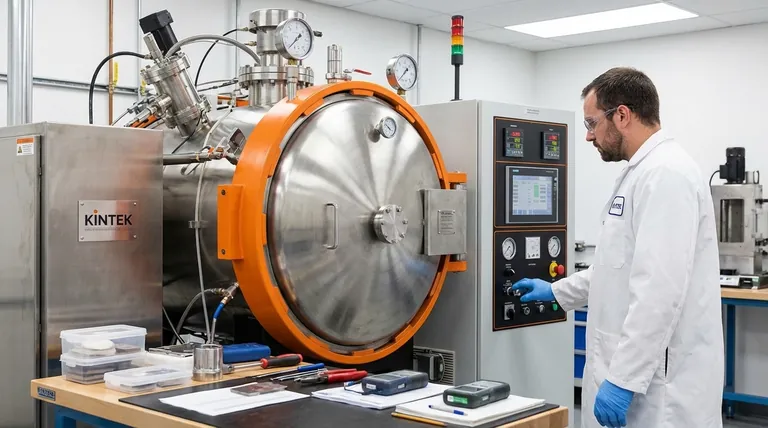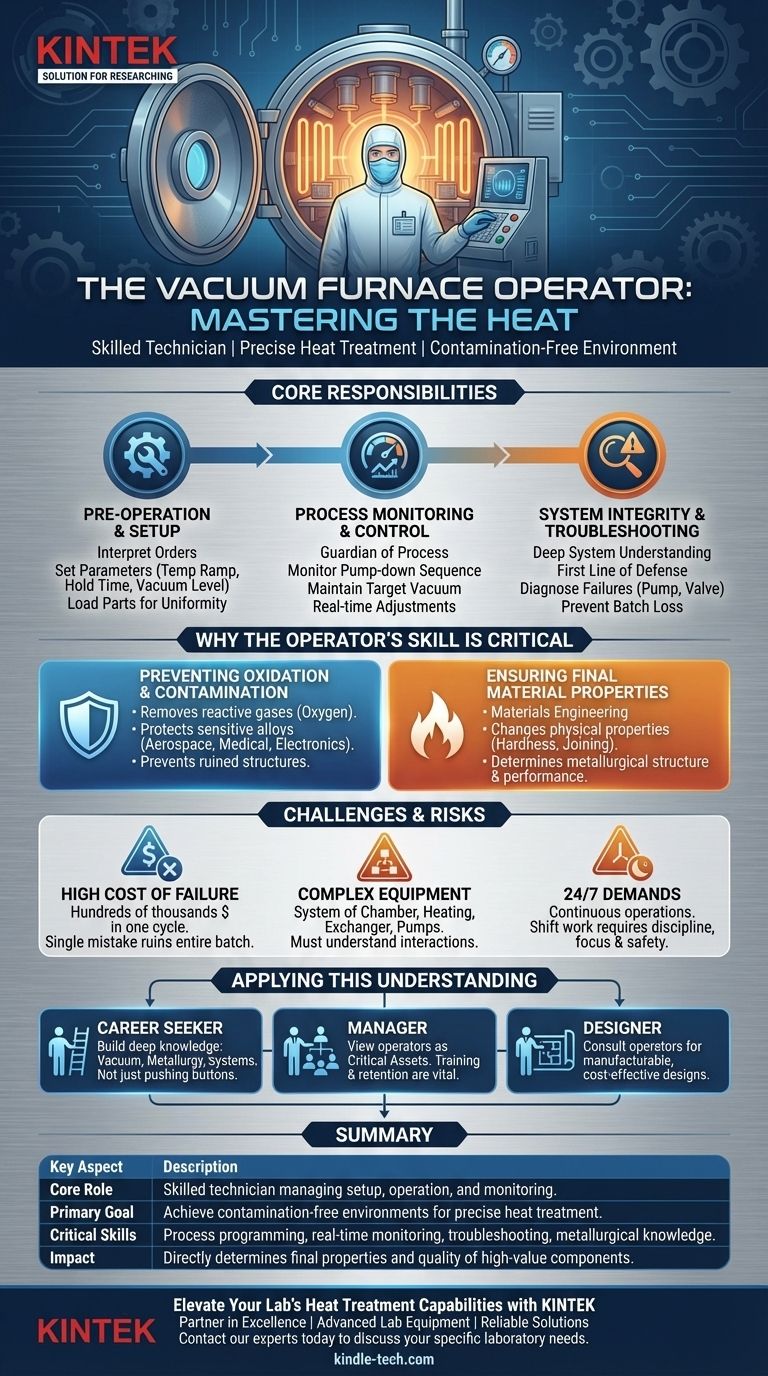At its core, a vacuum furnace operator is a highly skilled technician responsible for setting up, running, and monitoring a vacuum furnace to perform heat treatment processes like brazing, annealing, or hardening. They are not simply machine minders; they manage a complex system of pumps, valves, and controls to create a precise, contamination-free environment essential for processing high-performance materials.
A vacuum furnace operator is the critical human element in a sophisticated materials processing system. Their expertise ensures that the theoretical benefits of vacuum heat treating—purity, precision, and superior material properties—are actually achieved in the final product.

The Core Responsibilities of an Operator
A vacuum furnace is a complex apparatus that relies on an operator's skill to function correctly. While the reference mentions components like pumps, valves, and heat exchangers, it is the operator who orchestrates their use to achieve a specific outcome.
Pre-Operation and Setup
The operator's work begins long before the furnace heats up. They are responsible for interpreting work orders and technical specifications to program the correct processing cycle.
This involves setting precise parameters for temperature ramp rates, hold times, and vacuum pressure levels. They also carefully load parts into the furnace, ensuring proper placement for uniform heating and cooling.
Process Monitoring and Control
Once a cycle starts, the operator becomes the guardian of the process. They constantly monitor an array of gauges and readouts, watching the pump-down sequence as air is evacuated from the chamber.
Their primary task is to ensure the system achieves and maintains the target vacuum level. Any deviation or leak could introduce contaminants like oxygen, compromising the entire batch. They make real-time adjustments to ensure the cycle proceeds exactly as planned.
System Integrity and Troubleshooting
An operator must have an intimate understanding of the furnace's mechanical and electrical systems. They are the first line of defense against equipment failure.
If a vacuum pump falters or a valve fails to seal, the operator must quickly diagnose the issue. This ability to troubleshoot under pressure is what separates a novice from an expert and can prevent the loss of an extremely expensive batch of materials.
Why the Operator's Skill is Critical
The vacuum environment is what makes this type of heat treatment so valuable, but it is also inherently fragile. The operator's diligence is what protects this environment and guarantees the quality of the final product.
Preventing Oxidation and Contamination
The fundamental purpose of the vacuum is to remove reactive gases, primarily oxygen, that would cause oxidation and contamination at high temperatures.
A skilled operator ensures the vacuum is "deep" enough and stable enough to protect sensitive alloys used in aerospace, medical, and electronics applications. Without their vigilance, the material's surface and internal structure could be ruined.
Ensuring Final Material Properties
Heat treatment is a form of materials engineering. The process is designed to change a metal's physical properties—making it harder, softer, or joining it to another piece.
The precise control of temperature and vacuum, managed by the operator, directly determines the final metallurgical structure and, therefore, the performance of the part. An error of just a few degrees or a slight vacuum leak can result in a component that fails to meet specification.
Understanding the Challenges and Risks
The role of a vacuum furnace operator comes with significant responsibility and pressure. The value of the parts inside the furnace can often be exceptionally high.
The High Cost of Failure
A single processing cycle can contain hundreds of thousands of dollars worth of precision-machined components. A mistake by the operator—an incorrect setting, a missed alarm, or a slow response to a leak—can render the entire batch useless.
The Complexity of the Equipment
As described in the reference, a vacuum furnace is not one machine but a system of interconnected parts: a chamber, a heating system, a heat exchanger, and a complex vacuum system. The operator must understand how these elements interact to effectively run and troubleshoot the equipment.
The Demands of a 24/7 Environment
Many heat treatment facilities run continuously to maximize efficiency. Operators often work in shifts, requiring a high level of discipline and focus at all hours to hand off processes and maintain operational safety and quality.
Applying This Understanding
Recognizing the operator's role is key to success in any field that relies on advanced heat treatment.
- If you are considering this career path: Focus on building a deep knowledge of vacuum principles, metallurgy, and electromechanical systems, as this role is far more than just pushing buttons.
- If you are a manager in manufacturing: View your skilled operators as a critical asset whose training and retention are as important as the maintenance of the furnace itself.
- If you design parts requiring heat treatment: Consult with furnace operators to understand the practical realities of processing, as their feedback can lead to more manufacturable and cost-effective designs.
Ultimately, the vacuum furnace operator is the essential link between a powerful piece of machinery and a perfect, high-performance product.
Summary Table:
| Key Aspect | Description |
|---|---|
| Core Role | Skilled technician managing vacuum furnace setup, operation, and monitoring. |
| Primary Goal | Achieve contamination-free environments for precise heat treatment processes. |
| Critical Skills | Process programming, real-time monitoring, troubleshooting, and metallurgical knowledge. |
| Impact | Directly determines the final properties and quality of high-value components. |
Elevate Your Lab's Heat Treatment Capabilities with KINTEK
Your vacuum furnace is only as effective as the team that operates it. At KINTEK, we specialize in providing the advanced lab equipment and consumables that empower skilled operators to achieve unparalleled results. From precision furnaces to essential vacuum system components, our solutions are designed for reliability and performance in demanding environments.
Are you looking to enhance your heat treatment processes, improve product quality, or equip your team with the best tools for the job? Let KINTEK be your partner in excellence.
Contact our experts today to discuss your specific laboratory needs and discover how our solutions can drive your success.
Visual Guide

Related Products
- Vacuum Heat Treat Furnace and Levitation Induction Melting Furnace
- Vacuum Heat Treat Furnace with Ceramic Fiber Liner
- Molybdenum Vacuum Heat Treat Furnace
- 2200 ℃ Tungsten Vacuum Heat Treat and Sintering Furnace
- Vacuum Heat Treat Sintering Brazing Furnace
People Also Ask
- What are the four types of heat treating processes? Master Annealing, Normalizing, Hardening, and Tempering
- Why do you heat treat in a vacuum? Achieve Perfect Surface Finish and Material Integrity
- What is the process of vacuum quenching? Achieve Superior Hardness with a Pristine Surface Finish
- What are the three main heat treatments? Mastering Annealing, Hardening & Tempering
- What are the five basic heat treatment processes of metals? Master Annealing, Hardening & More



















